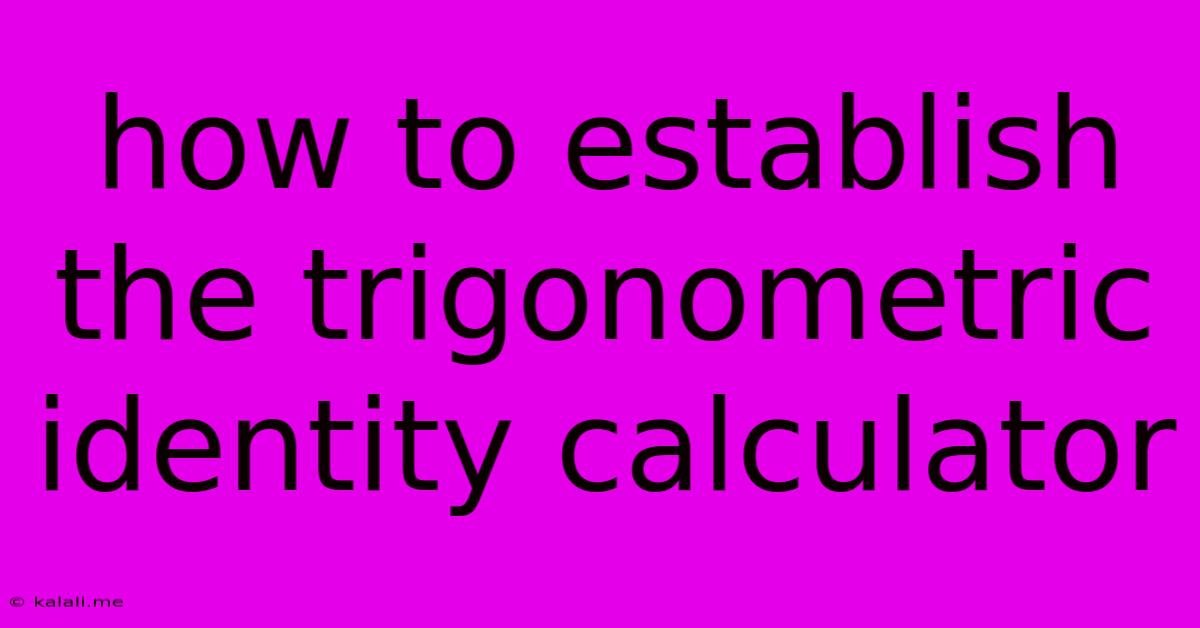How To Establish The Trigonometric Identity Calculator
Kalali
Jun 06, 2025 · 3 min read

Table of Contents
How to Establish a Trigonometric Identity Calculator: A Developer's Guide
This article provides a comprehensive guide on how to build a trigonometric identity calculator. We'll cover the core concepts, algorithms, and programming considerations involved in creating a robust and user-friendly tool. This guide is geared towards developers with some experience in programming and mathematics. Understanding trigonometric functions and identities is crucial.
What is a Trigonometric Identity Calculator?
A trigonometric identity calculator is a software application that verifies or proves trigonometric identities. It takes a trigonometric equation as input and determines whether it's an identity (true for all valid inputs) or not. This is achieved through a combination of algebraic manipulation, simplification, and the application of known trigonometric identities. The calculator might also show the steps involved in the verification process, enhancing its educational value.
Core Components and Algorithms:
Building a trigonometric identity calculator involves several key components:
1. Input Parsing and Validation:
- The calculator needs a robust parser to interpret the user's input, which may involve various trigonometric functions (sin, cos, tan, cot, sec, csc), variables (typically x or θ), constants, and arithmetic operators.
- Validation is crucial to ensure the input is well-formed and syntactically correct. Error handling should provide informative messages to the user about invalid input.
2. Trigonometric Function Evaluation:
- The calculator needs a library or functions to evaluate trigonometric functions accurately for various input values. Consider using existing mathematical libraries in your chosen programming language for efficiency and accuracy.
3. Identity Verification Algorithm:
- The core of the calculator is the algorithm that verifies identities. This usually involves a combination of techniques:
- Simplification: Using algebraic rules and trigonometric identities to simplify both sides of the equation. This may involve factoring, expanding, using common denominators, and applying known identities like Pythagorean identities (sin²x + cos²x = 1), sum-to-product identities, etc.
- Numerical Verification: For computationally intensive identities, numerical methods can be employed. The calculator evaluates both sides of the equation for a range of input values. If the difference between the two sides is within a predefined tolerance for all tested values, the identity is considered likely true. However, this approach only provides probabilistic verification, not definitive proof.
- Symbolic Manipulation: A more advanced approach involves implementing symbolic computation techniques. This allows the calculator to manipulate trigonometric expressions algebraically, just like a human would, leading to a more rigorous and conclusive verification. Libraries like SymPy (Python) can be helpful here.
4. Output Generation:
- The calculator should present the results clearly. Ideally, it should indicate whether the identity is true or false. For true identities, ideally, it should show the steps of the verification process, making the tool useful for learning.
Programming Considerations:
- Programming Language: Choose a language suitable for mathematical computation and symbolic manipulation. Python with libraries like NumPy and SymPy is a popular choice. JavaScript can be used for web-based calculators.
- User Interface (UI): Design a user-friendly interface for input and output. Consider using a text-based interface for simpler calculators or a graphical user interface (GUI) for more advanced versions.
- Testing: Thorough testing is essential to ensure the calculator's accuracy and reliability. Test with a wide variety of valid and invalid inputs, including edge cases and boundary conditions.
Advanced Features:
- Step-by-step solution: Displaying the intermediate steps of the verification process greatly enhances the educational value of the calculator.
- Interactive mode: Allow the user to input their own identities and receive feedback.
- Support for different notations: Handle various notations for trigonometric functions (e.g., sin x, sin(x)).
- Integration with Computer Algebra Systems (CAS): Leverage the power of CAS like Mathematica or Maple for more complex identities.
This comprehensive guide provides a roadmap for building a trigonometric identity calculator. Remember to focus on clarity, accuracy, and user-friendliness throughout the development process. The complexity will depend on your desired features and the level of mathematical rigor you aim for.
Latest Posts
Latest Posts
-
Old Dinosaurs On An Island Movies
Jun 07, 2025
-
Use An Ip Scanner To Find The Pis Ip Address
Jun 07, 2025
-
How Are Variations And Adaptations Similar
Jun 07, 2025
-
How Do You Adjust A Toilet Fill Valve
Jun 07, 2025
-
Does Stat Changes Carry Over Battles In Pokerogue
Jun 07, 2025
Related Post
Thank you for visiting our website which covers about How To Establish The Trigonometric Identity Calculator . We hope the information provided has been useful to you. Feel free to contact us if you have any questions or need further assistance. See you next time and don't miss to bookmark.